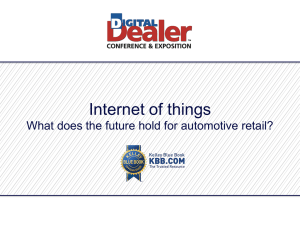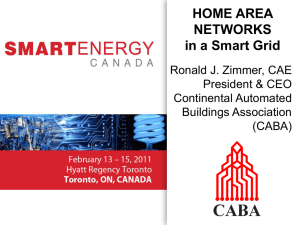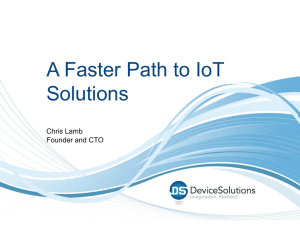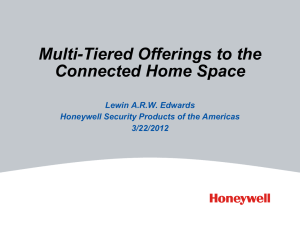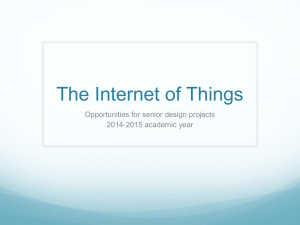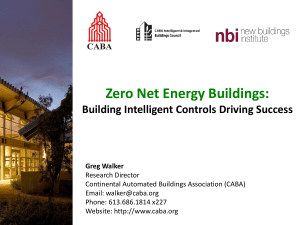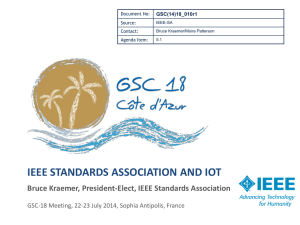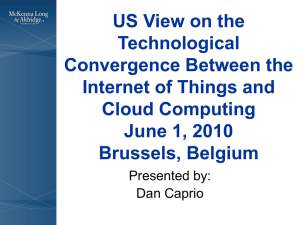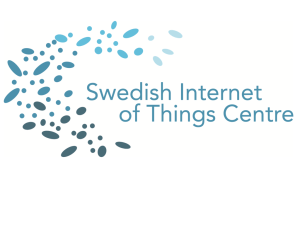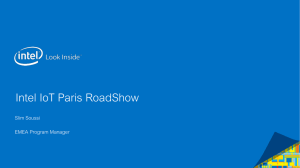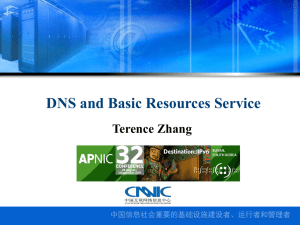November 5, 2014 - Continental Automated Buildings Association
advertisement
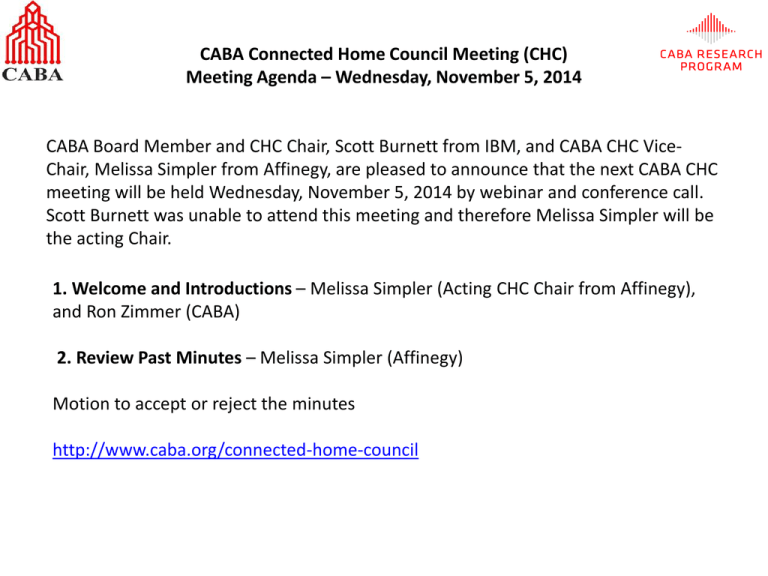
CABA Connected Home Council Meeting (CHC) Meeting Agenda – Wednesday, November 5, 2014 CABA Board Member and CHC Chair, Scott Burnett from IBM, and CABA CHC ViceChair, Melissa Simpler from Affinegy, are pleased to announce that the next CABA CHC meeting will be held Wednesday, November 5, 2014 by webinar and conference call. Scott Burnett was unable to attend this meeting and therefore Melissa Simpler will be the acting Chair. 1. Welcome and Introductions – Melissa Simpler (Acting CHC Chair from Affinegy), and Ron Zimmer (CABA) 2. Review Past Minutes – Melissa Simpler (Affinegy) Motion to accept or reject the minutes http://www.caba.org/connected-home-council 3. Research Update – Greg Walker (CABA) 3.1 CHC Landmark Research for 2014: ‘Connected Consumer Roadmap: Driven by the Internet of Things’ 3.2 Suggestion for 2015 CABA Research: Next Landmark Research – Security and Privacy in the Connected Home? Automotive? Interface & Speech Recognition? Adaptive Automation and Permission? Cognitive Home? …………………..? 3.3 CABA eStore: The CABA eStore offers primary research at a 10% discount to CABA members. Participating research companies include: BSRIA, Compass Intelligence LLC, IGI Group, Memoori, Navigant Research, and ON World. Link: http://estore.caba.org/ 4. CHC White Papers Update – Greg Walker (CABA) 4.1 Completed: “Convergence of the Connected Home and Car” Working Group: Compass Intelligence, Keith Robinson (author) Compass Intelligence - Amy Cravens Compass Intelligence - Dilip Saragan Bosch - Winson Wang IBM - Scott Burnett KEF Business Visioning - Ken Fairbanks Sustainable Resources Management - David Katz TELUS - Jordan Melzer Thomas & Betts - Dave Maccarone http://www.caba.org/connected-home-council 4.2 Approved Proposals in Progress: “Smart Home Office” Working Group: Asian Institute of Intelligent Buildings - Albert So (Author) University of Hong Kong – Kwok Wong (Author) Ken Wacks Associates - Ken Wacks Sustainable Resources Management - David Katz 4.3 General Discussion and Call for New White Paper Topics Industry Profile – Melissa Simpler (Affinegy) 5.1 IEEE and The Power & Energy Society (PES) Doug Houseman (EnerNex) The Power & Energy Society (PES) provides the world's largest forum for sharing the latest in technological developments in the electric power industry, for developing standards that guide the development and construction of equipment and systems, and for educating members of the industry and the general public. Members of the Power & Energy Society are leaders in this field, and they — and their employers — derive substantial benefits from involvement with this unique and outstanding association. 5.2 Standard for an Architectural Framework for the Internet of Things (IoT) Oleg Logvinov (STMicroelectronics) The Internet of Things (IoT) is a key enabler for many emerging and future “smart” applications and technology shifts in various technology markets. The IEEE P2413 standard defines an architectural framework for the IoT, including descriptions of various IoT domains, definitions of IoT domain abstractions, and identification of commonalities between different IoT domains. 6 DC@Home IEEE Global ICAD Approved • DC@Home a global IEEE activity – 520+ members – 400+ companies, universities and government agencies involved – More than 50 countries represented • The IEEE PES IGCC is the home for the activity 7 Current Plan Catalog of losses 10/14 8 Business Case Framework 2/14 List of Research Topics Required Standards 3/15 7/15 Recommendations to IEEE 1/16 9 Issues with Mixing DC and AC • Different physics • Different switching and routing characteristics • No zero crossing in DC for equipment to use to soft start and stop on 4 Choices • Mix AC and DC on the same system • Create new DC wiring for new homes only • Create new DC wiring for renovations as well as new homes • Move to DC only in the home 10 11 Power Losses in a typical House • Each conversion AC to DC , DC to AC and DC to DC results in loss of energy (typical loss in each conversion is about 5 to 10%) • Resistive Losses • Battery charging and discharging (~5-10 % losses in each cycle) • Standby power losses (Total standby power loss in the California homes ranged from 14 to 169 W, with an average of 67 W. This corresponds to 5–26% of the homes annual electricity use [1]) 12 House Devices That Run Primarily on DC • Primary electrical power source of all appliances is DC power. – Air conditioners, heat pumps and furnaces – Washers and dryers – heavy duty food processors, refrigerators, freezers • Brushless DC permanent magnet motors driven by variable frequency drives (VFD). A VFD initially rectifies the AC input to DC, then applies pulse width modulation to create the desired output frequency and phase. DC powered VFDs can bypass the losses associated with power rectification. • Clocks and controls all electronics based – also DC • In essence all household appliances can run efficiently on DC. 13 Table III: AC Power Losses for Modeled Loads 14 AC vs DC Energy Loss Comparison (43 % Less Loss) 15 Additional Cost Considerations of DC Power Based on DC , PV system cost is reduced by about 20% In addition to cost savings, PV systems based on DC are more reliable Batteries, and capacitors, store dc power. AC power increase the cost of batteries (as much as 50 % in some cases) [16] DC use increases the competitiveness of manufacturing industry and saves jobs worldwide. Energy cost is as great as 33% of the operating cost of the manufacturing plant (Aluminum industry can save ~$10 B/year) Worldwide adoption of dc power can provide uniform voltage standards worldwide, thus reducing the cost of related power electronics to yield an overall lower manufacturing cost of all dc-based electrical equipment and systems. DC power is also enabler of flexible integrarion of distributed generation into energy network [17] 16 PV Generated DC Electricity for People Who Have No Access to Electricity • Over 1.5 billion people are without access to electricity. • Another 3.0 billion rely on wood, charcoal, dung and coal for cooking and heating, which results in over four million premature deaths a year due to indoor air pollution. • 800 million people have no access to clean water for drinking • PV Generated DC, volume manufacturing of PV systems and batteries, vertically integrated business model, and , and a targeted monetary policy of quantitative easing can rapidly power all human activities Possible DC Timeline Timeline thanks to Harry Stokman – Direct Current Session 6: Standards - the bridge to innovation Oleg Logvinov Director, Special Assignments, Industrial and Power Conversion Division, STMicroelectronics Chair, IEEE P2413 Working Group “Standard for an Architectural Framework for the Internet of Things (IoT)” Member, Corporate Advisory Group, IEEE-SA Member, Standards Board, IEEE-SA Email: oleg.logvinov@st.com October 28, 2014 Who we are • A global semiconductor leader • The largest European semiconductor company • 2013 revenues of $8.08B • Approx. 45,000 employees worldwide • Approx. 9,000 people working in R&D • 12 manufacturing sites • Listed on New York Stock Exchange, Euronext Paris and Borsa Italiana, Milano As of December 31, 2013 19 Where you find us Our MEMS & Sensors are augmenting the consumer experience Our automotive products are making driving safer, greener and more entertaining Our digital consumer products are powering the augmented digital lifestyle Our Microcontrollers are everywhere making everything smarter and more secure Our smart power products are allowing our mobile products to operate longer and making more of our energy resources 20 21 New Things to Augment Life 22 Smart City Reduce traffic congestion Better use of resources Improve security Smart Me Healthcare Empower patients Smart Car Help physicians monitor and diagnose remotely Reduce emissions Increase safety Save fuel Smart Me Fitness & Wellness Help to lead healthier lives Smart Home Make entertainment more interactive and immersive Increase comfort Save energy Optimize sports performance Early warning of illness Expanding to Make Things Smarter Beyond the Smartphone Smart Home Smart City Smart Car Wearable 23 24 25 26 The Opportunity Billion Units Installed Base 201 3 202 0 13 Billion 36 Billion 27 “Thing Sense Connecte d Devices (“Nodes” ) Process Connect Translate Mobile devices Hubs and Gateways Power Augmented Things Source: ABI Research The Birth of the IEEE P2413 • P2413 is an outgrowth of a multi-year series of IoT Standards workshops and roundtables to understand requirements by vested stakeholders in the evolving IoT environment. • P2413 was initiated through the guidance of the IEEE-SA’s Industry Strategic IoT Team with a focus to integrate market needs with the developing IoT technology landscape. • The IEEE-SA Corporate Advisory Group (representing 200+ industry members) provides sponsorship for P2413 to maintain a balanced focus on industry / market / technology and standards ecosystem requirements within the development framework. IEEE P2413 Purpose and Motivation • The Internet of Things (IoT) is a key enabler for many emerging and future “smart” applications and technology shifts in various technology markets. This ranges from the Connected Consumer to Smart Home & Buildings, E-Health, Smart Grids, Next Generation Manufacturing and Smart Cities. It is therefore predicted to become one of the most significant drivers of growth in these markets. • Most current standardization activities are confined to very specific domains and stakeholder groups. They therefore represent islands of disjointed and often redundant development. The architectural framework defined in this standard will promote cross-domain interaction, aid system interoperability and functional compatibility, and further fuel the growth of the IoT market. 29 IoT Application Domains & Stakeholders* Hospitals & Doctors Consumer equipment providers Insurance companies Consumers Healthcare Home & Building Media ICT infrastructure providers Appliances providers Facility management Regulators Logistics Logistics companies Public transport companies IoT architecture frame work Retail Retail stores Application developers Mobility/ Transportation City authorities Manufacturing industries Energy Utilities Manufacturing Automation equipment providers * due to the diversity of IoT application areas only selected domains and stakeholders are shown 30 IEEE P2413 Goals • Accelerate the growth of the IoT Market by enabling cross-domain interaction and platform unification through increased system compatibility, interoperability and functional exchangeability • Define an IoT architecture framework that covers the architectural needs of the various IoT Application Domains • Increase the transparency of system architectures to support system benchmarking, safety, and security assessments • Reduce industry fragmentation and create a critical mass of multistakeholder activities around the world • Leverage the existing body of work 31 IEEE P2413 External interactions • For a unified IoT Architectural Framework it is essential to interact with standardization activities for IoT-based vertical applications to • Cover the various applications, their requirements and specific IoT functionalities in the IoT Architectural Framework • Ensure that the framework can be referenced by these standardization activities • Besides interactions with standardization activities within IEEE, P2413 will strive to establish liaisons with other standardization bodies. • An initial set of liaisons will include IEEE 802.24, IEC SG8, and oneM2M 32 IEEE P2413 Scope 33 • This standard defines an Architectural Framework for the IoT, including descriptions of various IoT domains, definitions of IoT domain abstractions, and identification of commonalities between different IoT domains. • The Architectural Framework for IoT provides: • reference model that defines relationships among various IoT domains (e.g., transportation, healthcare, etc.) and common architecture elements • reference architecture that: • builds upon the reference model • defines basic architectural building blocks and their ability to be integrated into multitiered systems • addresses how to document and mitigate architecture divergence. • blueprint for data abstraction and the quality "quadruple" trust that includes protection, security, privacy, and safety. IEEE P2413 Membership • • • • • • • • • • • • Broadcom Corporation dZhON Pty. Ltd. General Electric Huawei Technologies Institute for Information Industry (III) Marvell Semiconductor, Inc. Qualcomm Inc. Schneider Electric Starnberger Innovation & Technologie GmbH Toshiba Corporation Yokogawa Electric Corporation ZigBee Alliance • • • • • • • • • • Cisco Systems Emerson Hitachi, Ltd. Infocomm Development Authority (IDA) Itron Inc. Oracle Rockwell Automation Siemens AG STMicroelectronics Wuxi Sensing Net Industrialization Research Institute 34 IEEE P2413 Organization • To accelerate the development process P2413 has launched a number of Sub-Working Groups and Ad Hocs • Sub-Working Groups: • Scope and Applicability • Standardization Landscape • Networking • Ad Hocs • oneM2M review • Work completion timeline: 2016 35 IEEE P2413 Working Group Meetings • First WG Meeting: • 10-11 July 2014 • Hosted by Siemens in Munich, Germany • Second WG Meeting: • 16-17 September 2014 • Hosted by STMicroelectronics in Santa Clara, CA USA • Third WG Meeting: • Teleconference, • Fourth WG Meeting: • 22-23 January in Taipei • Fifth meeting • 27-28 April, Europe 36 P2413 – Conclusions • P2413 recognizes the evolving transformational integration and convergence across technology and application domains. • P2413’s goal is to provide an extensible integrated architectural framework that will continue to evolve and unify the standards creation effort. • P2413 will continue to deepen industry engagement by leveraging global IoT workshops, webinars, roundtables and other tools of the IEEE IoT Initiative. • P2413 is an open community and all are welcome to participate and to share perspectives on addressing and preparing for the inter-connected world of 2020. Join us! Join the IEEE P2413 Working Group http://grouper.ieee.org/groups/2413/ For additional information, please contact: Oleg Logvinov P2413 Chair oleg.logvinov@st.com or Brenda Mancuso IEEE-SA Project Manager blmancuso@ieee.org 38 Thank you! 6. Next CABA Intelligent Buildings & Digital Home Forum – Greg Walker (CABA) The CABA Intelligent Buildings & Digital Home Forum will be held in Austin, Texas from April 14 - 16, 2015. CABA will be collocating with the Broadband Community Summit, which will have a combined total of 1,000+ industry professionals. For more information on this event, please go to: http://www.caba.org/caba-forum-2015. Also included with the Connected Home Sessions are Keynotes, receptions, networking events, and an IBM Labs tour hosted by IBM. The CHC (face-to-face) meeting will also be held at this event, more info will be forwarded in the near future. 6.1 Call for Session Topics 6.2 Call for Speakers (Keynote and session) 6.3 Call for Research Workshop Topics 7. CABA Strategic Plan – Ron Zimmer (CABA) 8. Call for New Business – Melissa Simpler (Affinegy) CES (Consumer Electronics Show)? Potential work and projects that CABA should undertake or forward to the CABA Board of Directors: http://www.caba.org/board 9. Adjournment (1:30 PM ET) – Melissa Simpler (Affinegy) Next CHC Meeting – January 2015 via Webinar =========================================================================== You can view all CHC participants, past minutes, etc. at: http://www.caba.org/connectedhome-council . Don’t hesitate to contact the CABA office (613.686.1814 X228/ 888.798.CABA) if you have any questions about the forthcoming CHC meeting. This CABA meeting is normally only open to CABA members; however guests may be invited to this meeting. Working Group Leaders and Chairmen will be expected to present an update of their work since the last meeting. Please forward this invitation to others in your organization or industry that you feel may want to participate in this CHC meeting or the CABA Forum.
